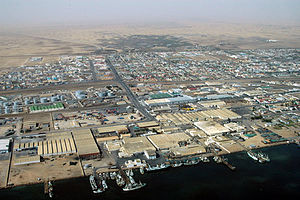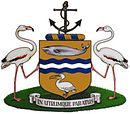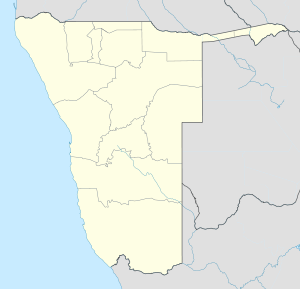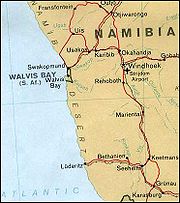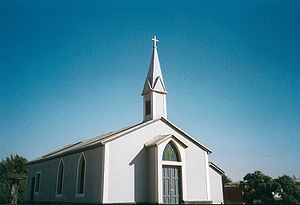
Walvis Bay
Background to the schools Wikipedia
The articles in this Schools selection have been arranged by curriculum topic thanks to SOS Children volunteers. SOS mothers each look after a a family of sponsored children.
| Walvis Bay | |||
|---|---|---|---|
| — City — | |||
| Aerial photo of the harbour area | |||
|
|||
| Motto: In utrumque paratus | |||
|
|
|||
| Coordinates: 22°57′22″S 14°30′29″E | |||
| Country | |||
| Region | Erongo Region | ||
| Established | 1840 | ||
| Government | |||
| • Mayor | Uilika Nambahu | ||
| Area | |||
| • Total | 434 sq mi (1,124 km2) | ||
| Population (2001) | |||
| • Total | 60,000 | ||
| • Density | 65.2/sq mi (30.4/km2) | ||
| Time zone | WAT ( UTC+1) | ||
| • Summer ( DST) | WAST ( UTC+2) | ||
Walvis Bay (Afrikaans Walvisbaai, German Walfischbucht or Walfischbai, all meaning "Whale Bay"), is a city in Namibia and the name of the bay on which it lies.
The bay has been a haven for sea vessels because of its natural deepwater harbour, protected by the Pelican Point sand spit, being the only natural harbour of any size along the country's coast. Being rich in plankton and marine life, these waters also drew large numbers of whales attracting whalers and fishing vessels. The Dutch referred to it as Walvisch Baye and the English as Whale Bay, and in its eventual proclamation it came to be called Walfish Bay, and eventually Walvis Bay. It has also been referred to as Walwich Bay or Walwisch Bay.
A succession of colonists developed the location and resources of this strategic harbour settlement. The harbour's value in relation to the sea route around the Cape of Good Hope had caught the attention of world powers since it was discovered. This explains the complicated political status of Walvis Bay down the years.
The town is situated in the Kuiseb river delta and lies at the end of the TransNamib Railway to Windhoek, and on the B2 road.
Walvis Bay, with its large bay and sand dunes, is the tourism activity centre of Namibia. Other attractions include the artificial Bird Island, centre of a guano collection industry, the Dune 7 sand dune, salt works, birdlife and a museum. Kuisebmund Stadium, home to two clubs in the Namibia Premier League, is also located in the city and the beach resort of Langstrand lies just a few kilometers north. The Walvis Bay Export Processing Zone is an important facet of the local economy.
History
Portuguese navigator Diogo Cão reached what was called "cape Cross", north of the bay, in 1485. He was followed by Bartolomeu Dias, who anchored his flagship São Cristóvão in what is now Walvis Bay on 8 December 1487, on his expedition to discover a sea route to the East via the Cape of Good Hope. He named the bay "O Golfo de Santa Maria da Conceição." However, the Portuguese did not formally stake a claim to Walvis Bay.
Little commercial development occurred on the site until 1840, when in the scramble for Africa, Britain, the dominant seafaring nation at the time, annexed Walvis Bay and a small area surrounding the territory in 1878 as part of Cape Colony both to forestall German ambitions in the region and to ensure safe passage of British ships around the Cape. In 1910, Walvis Bay, as well as the Cape Colony, became part of the newly formed Union of South Africa. However, a dispute arose with Germany over the enclave's boundaries. This was eventually settled in 1911 and Walvis Bay was allocated an area of 434 square miles (1,124 km2).
The enclave was overrun by the Germans during the South-West Africa Campaign early in World War I. But South African Forces eventually ousted the Germans in 1915 and Walvis Bay was quickly integrated into the new martial law regime established in South-West Africa. South Africa was later awarded control (a "C" class mandate) over South-West Africa by the League of Nations to administer SWA as an integral part of South Africa. Civilian rule was restored in South-West Africa in 1921 and administration of Walvis Bay was transferred to SWA by Act of the South African parliament in 1922.
In 1971, anticipating an imminent ceding of its control over South-West Africa, South Africa transferred control of Walvis Bay back to its Cape Province. In 1977, in an attempt to avoid losing control of Walvis Bay to a possibly hostile SWAPO-led government, the South African government reimposed direct rule and reasserted its claim of sovereignty based on the original annexation. In 1978, the United Nations Security Council provided for bilateral negotiations between South Africa and a future Namibia to resolve the political status of Walvis Bay.
In 1990 South-West Africa gained independence as Namibia but Walvis Bay remained under South African sovereignty. At midnight on 28 February 1994 sovereignty over Walvis Bay was formally transferred to Namibia, and also over the Penguin Islands.
Education
In Walvis Bay there are a lot of government and private schools such as Duinesig primary school, De duine secondary school, International School of Walvis Bay, Kuisebmond secondary school, Walvis Bay Private High School and others. There are a lot of kindergartens too and some tertiary institutions like NAMFI, Monitronic success college and IUM. At NAMFI people study to be deck officers, fishermen, marine engineers and other careers in fishing and working under water.
Fishing
In Walvis Bay there are different fishing companies like Hangana Seafood,Caroline Fishing, Benguella Fishing Company, Etale Fishing Company, Cadilu Fishing, Etosha Fisheries, Kuiseb Fishing Enterprises, Blue Ocean Products, Benguella Sea Products, Consortium Fisheries. These companies catch different types of fish like snoek, horse mackerel, anchovy, steenbras, kabeljou, kingklip, hake, catfish, tuna, and sardines. Hangana Seafood are processors and exporters of fish and fish products.
Entertainment and sport
Walvis Bay is blessed with wide open spaces, scenic beauty and unique marine and plant life. It is well suited for the outdoor lifestyle, boasting sports such as sandboarding, kiting, surfing, swimming, angling, sailing, golf and other in- and outdoor sport codes.There is Walvis Bay Lagoon and Aquatic Activities, Kuiseb River Delta and the beach itself where by people enjoy swimming and catching fish. The low peninsula gives the bay a unique combination of strong wind and shallow waves, ideal for record attempting vessels like Vestas Sailrocket
It is home to Eleven Arrows F.C., a local football club that is participating in the Namibia Premier League.
Climate
Walvis Bay features the very rare mild variation of the arid climate. Walvis Bay receives an average of only 83 mm of precipitation per year, making it one of the driest cities on the planet. Despite the fact that it has an arid climate, Walvis Bay seldom gets very hot or very cold, an extremely unusual feature for a city featuring this climate. This is primarily due to cold offshore currents near Walvis Bay. Temperatures averages around 24°C during January, Walvis Bay's warmest month and around 17°C during July, its coldest month.
| Climate data for Walvis Bay | |||||||||||||
|---|---|---|---|---|---|---|---|---|---|---|---|---|---|
| Month | Jan | Feb | Mar | Apr | May | Jun | Jul | Aug | Sep | Oct | Nov | Dec | Year |
Literature
- Silverman, Melinda: Between the Atlantic and the Namib. An Environmental History of Walvis Bay, NWG, Windhoek 2004 - Namibiana Buchdepot
- de Beer, Charles: Namibia Marine Life, @tidude Graphix, Swakopmund o.J. - Namibiana Buchdepot
- Heemstra, Phillip; Smith, Margaret M.: Smith's Sea Fishes, Struik Publishers, Cape Town 2003
- Bridgeford, P. and M.: Cape Cross, Walvis Bay 2002 - Namibiana Buchdepot
- Vogt, Andreas: National Monuments in Namibia, Gamsberg Macmillan, Windhoek 2004 - Namibiana Buchdepot
